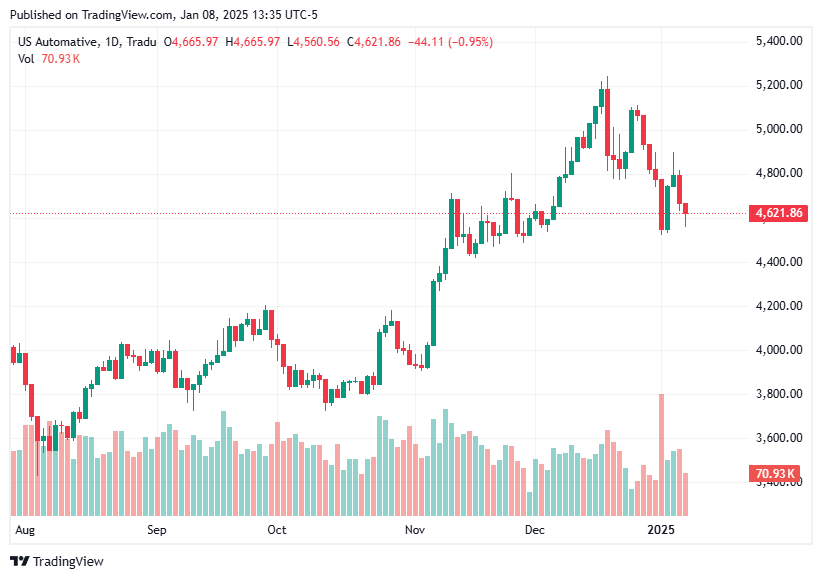First Look at Local Automotive Markets in December
Tracking Inventory, Sales, and Trends Across the U.S.
January 8, 2025
As we wrap up 2024, the U.S. automotive market reflects a mix of shifting consumer preferences, growing inventory levels, and dynamic sales trends across new and pre-owned vehicles. This article offers the first look at local automotive market data for December, analyzing trends in inventory, new listings, and sales performance. With comparisons to pre-pandemic benchmarks, it’s clear the industry is navigating a transformative period.

New Vehicle Inventory in December
Key Insights:
Total inventory across early reporting automotive markets increased by 23.4% year-over-year in December.
Inventory growth was most pronounced in the SUV and electric vehicle (EV) segments, reflecting changing consumer demand and production catch-up from earlier supply chain issues.
Comparing to December 2019, inventory for sedans is still 13% below pre-pandemic levels, while SUVs and trucks have seen inventory growth of over 15%.
Regional Highlights:
Southeast markets (Florida, Georgia): Inventory increased by 35% YoY, driven by aggressive restocking and demand for larger vehicles.
West Coast (California, Washington): EV inventories surged, but oversupply concerns linger, particularly for models from second-tier EV manufacturers.
Northeast (New York, Pennsylvania): Moderate inventory growth (+18%), reflecting more balanced supply-demand dynamics.
New Vehicle Listings in December
New listings are a vital metric for gauging market activity. Here’s what we observed:
Overall new vehicle listings were up 15.7% YoY, rebounding from stagnation earlier in the year.
Listings for luxury vehicles (BMW, Mercedes, Lexus) increased by 22% YoY, signaling continued consumer interest in premium segments despite higher interest rates.
Compared to December 2019, new listings remain 7% lower, reflecting lingering caution from manufacturers to overproduce.
Notable Trends:
Manufacturers are prioritizing hybrid and plug-in hybrid vehicles, with listings in these categories up by 30% YoY, aligning with increased consumer awareness and state-level incentives.
Sedans saw the slowest recovery, with listings up only 9% YoY, reflecting ongoing preference for SUVs and crossovers.
Sales Performance in December
Closed Sales:
December new vehicle sales across early reporting markets rose 14.5% YoY, supported by year-end promotions and more robust inventory levels.
Pre-owned vehicle sales increased 12.2% YoY, driven by falling prices for used EVs and hybrids, which are finally becoming more accessible to budget-conscious buyers.
Seasonal Adjustments:
December 2024 had one more working day than December 2023, slightly boosting YoY sales figures.
When adjusted for seasonality, sales remain 8.6% below December 2019 levels, showing the market has yet to fully recover to pre-pandemic norms.
Pre-Owned Market Trends
Key Developments:
The average price of pre-owned vehicles fell to $27,400, down from $28,900 in December 2023. This is a welcome relief for consumers but signals potential margin pressures for dealerships.
Negative equity in trade-ins surged, with 25% of trade-ins now underwater, creating challenges for lenders and dealerships alike.
EVs dominate the decline in pre-owned prices, with models like the Tesla Model 3 and Chevy Bolt seeing price drops of 15-20% YoY, a reflection of rapid depreciation amid technology advances.
Comparisons to 2019
Inventory:
Inventory for SUVs and trucks has surpassed 2019 levels, while sedans and compact cars lag behind.
Sales:
December 2024 sales remain 12% below December 2019, indicating a slower recovery trajectory.
Looking Ahead to 2025
As we enter 2025, several trends will shape the automotive market:
Interest Rates Remain a Factor: With auto loan rates hovering at 9.6% for new vehicles and 13.8% for pre-owned, affordability remains a challenge, likely driving more consumers toward leasing.
Leasing Revival: Leasing penetration, which dropped to 18% in 2024, is expected to recover slightly in 2025 as manufacturers incentivize leases to drive customer retention.
EV Market Oversupply: Dealers and manufacturers must address growing EV inventories through pricing strategies, trade-in incentives, and enhanced infrastructure for charging.
Pre-Owned Market Adjustments: Falling used vehicle prices could attract buyers but may create challenges for dealerships with high inventory acquisition costs.
Closing Thoughts
The automotive market’s December performance underscores both progress and ongoing challenges. As manufacturers and dealers recalibrate strategies, the focus will shift to aligning production with demand, addressing affordability, and navigating macroeconomic headwinds. While the market won’t likely return to 2019 norms in 2025, incremental growth, especially in the EV and hybrid segments, points to a resilient industry adapting to change.
What are your predictions for the automotive market in 2025? Share your insights below!



